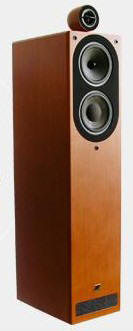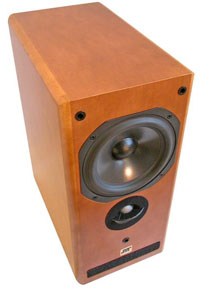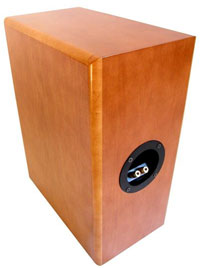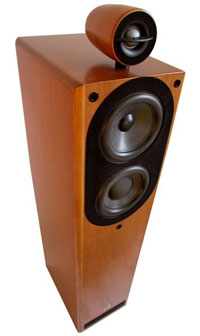You are reading the older HTML site
Positive Feedback
ISSUE
25
may/june
jm reynaud
Cantabile Signature and Twin Signature loudspeakers
as reviewed by Tom Campbell

|
TOM CAMPBELL'S SYSTEM
LOUDSPEAKERS
ELECTRONICS
SOURCES
CABLES
ACCESSORIES
|
Reynaud is not a well-known audio brand in the U.S., but it should be. In each of its products, this French loudspeaker manufacturer delivers just about everything dear to an audiophile's heart: rock-solid build quality, handsome styling, and above all, truly exciting music making—at eminently reasonable prices.
The hardest speakers to review are those that don't do anything glaringly wrong but don't quite do anything exceptional either. When forced to describe their sound, these speakers are hard to fault—and also, whether the reviewer is conscious of it or not, hard to get excited about. I know the reviews that stick in my mind as products to officially consider are not necessarily the ones where nary a negative word is spoken about a particular item; the reviews I remember are the ones where the writer sounds truly jazzed. And even if the logical, analytical left brain of the reviewer finds a few caveats, I'm most interested in what the right brain has to say.
Reynaud speakers are the products of a designer who balances his right and left brain exceedingly well to my way of thinking. They are superbly well-engineered, but JM Reynaud undoubtedly has the heart of an artist. His speakers do most things right in a left-brain kind of way, but also have an idiosyncratic je ne sais quoi that sets them apart from the crowd. They may not be the best choice for the more analytical among us, but they manage to communicate a musical truth that few speakers do, and are the most truly "live"-sounding speakers I've heard in my home.
In the interests of full disclosure, I must mention that the Twin Signature and Cantabile Signature speakers were supplied to me for audition by the American distributor for Reynaud—and my fellow Positive Feedback writer—Bob Neill. Since starting his Amherst Audio boutique, Bob has written mostly music reviews for PFO. The two of us shared some back-and-forth dialogue during the review process, but never at any point did he attempt to exert any influence on my conclusions. Disclosure completed and I hope case closed. Off we go!
Bob was actually taking a chance with me, because any speakers sent to me for review are to some extent at an immediate disadvantage. My reference speakers, the Harbeth Compact 7-ES monitors, are by a wide margin the longest-lived link in my audiophile chain. I have numerous times referred to them in print as "my beloved Harbeths." I am so in thrall to their way—a very slightly mellowed but otherwise exemplary top-to-bottom tonal accuracy—that most other speakers I've auditioned have struck me as unexceptional or unacceptable (the classic Spendor models are the only others that have seriously competed for my affection, and I have a pair of their smallish 3/1P monitors as my back-ups). Some of those other speakers may have been faster, more detailed or more dynamic, but when you don't get tonality right, you've stumbled right out of the starting gate.
I got
acquainted with the Reynaud house sound via their entry-level Twin Signature
model. (The Signature editions are refined and upgraded versions of the original
models, and are the only versions of said models currently available.) The
Twins are small (17" high, 14" deep, 8" wide) and my listening room is quite
large (about 26' long by 14' wide). But darned if the little Twins did not fill
the space with vibrant, tonally rich, and wholly involving sound.

As one might expect, the Twins' forte was small-scale pop, rock and chamber classical. Give them something "big" like Stokowski in Living Stereo (the recent Rhapsodies SACD reissue), and the constriction was noticeable. But listening to a Japanese CD reissue of XTC's English Settlement was a real "wow" experience: alive in a way that made my (beloved) Harbeths sound downright buttoned-up. Bass was surprisingly good for such a small box, giving Barry Andrews' drum kit real thwack and Colin Moulding's fretless electric bass a real foundation. When this album was made in 1982, XTC was just making the transition from a tight, well-oiled touring band to a studio-only collective, and the live-on-the-floor sound of many of these tracks really came through via the Twins.
 On this and
other discs, the Twins' sound-staging did not nail the players to a precise
point in an artificial way, but gave each musician his own little cushion of air—just as a performance would sound in person. In fact, these little monitors
delivered the adrenalin rush of live music amazingly well. The Twins combine
the airiness and speed associated with electrostatic speakers with the bass
integration and coherence that drivers do best. At $1,060 for the pair, they
are a true audiophile experience. If your listening room is on the smallish
side, they may be all you'll ever need.
On this and
other discs, the Twins' sound-staging did not nail the players to a precise
point in an artificial way, but gave each musician his own little cushion of air—just as a performance would sound in person. In fact, these little monitors
delivered the adrenalin rush of live music amazingly well. The Twins combine
the airiness and speed associated with electrostatic speakers with the bass
integration and coherence that drivers do best. At $1,060 for the pair, they
are a true audiophile experience. If your listening room is on the smallish
side, they may be all you'll ever need.
But in my big living room I did miss some of the weight and scale of a larger speaker. So after spending a couple of weeks with the Twins, I was anxious to get the floorstanding Cantabiles in my system, expecting a bigger, even better version of the Twins. That's not quite what I got. The Cantabiles are fussier, with a slightly different character than their little brothers. But they are still very much Reynauds, with a near-magical presence and immediacy.
The Cantabiles are a transmission line design, with a slotted front port at the bottom and a silk dome tweeter that sits on top of the main cabinet. A transmission line is a rather complicated bass-delivery system that involves a long line coiling its way through the main cabinet and to the port. Some manufacturers play fast and loose with the term, but a true transmission line design is difficult and costly to manufacture. When it's done correctly and well, as it is in the Cantabiles, the resultant bass has a tightness, tunefulness and musical "rightness" that make most conventional woofers sound a bit wooly.
I had to work a little, though, to get the Cantabiles to sound right in my system and in my room. I quickly figured out that the speakers performed best at least three feet from the back wall, and at least the same distance from the side walls. But at first, the Cantabiles seemed a collection of great parts that wasn't quite coming together. Most notably, the treble seemed discontinuous with the bass, and I wondered if that top-mounted tweeter was to blame. My sensitivity in this area is pretty keen, both by predilection and training (one of the undoubted strengths of my reference Harbeths is the integration of their tweeter and woofer; they speak with one voice about as well as any speaker at any price). But with the Cantabiles, listening to any recording mixed or mastered a bit hot—which, of course, the majority of CDs are these days—resulted in a too-strident sound where the tweeter seemed to be overpowering the bass cabinet. My somewhat "live" listening room may have been partly to blame, but I hadn't experienced this with other speakers in the same room.
Let's face it, whether one has a relatively modest or super-high-end system, proper matching is more than half the battle. So I set about seeing what I could do to help the Cantabiles give of their best. Cables were the obvious first line of experimentation. The low-priced but high-performing MAC cables I currently use are exceptionally smooth and a tad warm, so I doubted that they were contributing to the hardness I was hearing. But sometimes perfectly good cables and components make poor electrical matches, and things got better when I threw a pair of FLEXYGY speaker cables from River Cable into the mix. They got even better when I substituted the single-wire Rivers for bi-wire Audio Note speaker cables. I don't know if it was primarily the bi-wiring or the excellence of the Audio Notes (or both), but on the SACD of Hilary Hahn playing the Elgar violin concerto, the tonality was sweeter, the orchestral sound better balanced, and the stridence substantially tamed. Continued listening over the next few days confirmed these impressions, but even so my satisfaction with the Cantabiles varied from recording to recording. The excess top-end action was alleviated, but not gone.
No speaker should be reviewed with only one amplification source, and I suspected that the Cantabiles just were not digging my solid-sate Coda/Continuum Unison integrated. The Unison has performed faultlessly with everything I've fed it over the last couple of years—it is so clean and consistent that I almost forget about it as a factor—but it turned out to be a mismatch in this case. Swapping out the Unison for the softer-voiced Marsh separates—tube preamp and solid-state power amp—was the "A ha!" moment with the Cantabiles. From there on, it pretty much all came together.
 The Cantabiles,
like the Twins, are great rock ‘n roll speakers that communicate both the
top-end energy and bass power that the music demands. During one weekend LP
marathon, the Ramones' eponymous first album, the Stooges' Fun House, and
Nirvana's Nevermind all brought the house down, making it both impossible
to stay seated and impossible to do anything but focus entirely on the music. As afternoon turned to evening, Edith Frost's spare and sweetly melancholy new
song cycle, It's a Game, sounded every bit as good.
The Cantabiles,
like the Twins, are great rock ‘n roll speakers that communicate both the
top-end energy and bass power that the music demands. During one weekend LP
marathon, the Ramones' eponymous first album, the Stooges' Fun House, and
Nirvana's Nevermind all brought the house down, making it both impossible
to stay seated and impossible to do anything but focus entirely on the music. As afternoon turned to evening, Edith Frost's spare and sweetly melancholy new
song cycle, It's a Game, sounded every bit as good.
It's a reviewing cliché that speakers that excel at rock ‘n roll well don't fare as well with classical and acoustic-based music—and quite a few listeners seem perfectly happy to accept this trade-off in one direction or the other. But Reynaud speakers don't optimize one at the expense of the other. On the new disc from the nouveau bluegrass outfit Nickel Creek, Why Should the Fire Die?, the Cantabiles were just as spectacular at conveying the string action and breathtakingly fast finger-picking on acoustic guitar and mandolin as they were at delivering the crunch of Kurt Cobain's multi-layered electric guitars.
With classical music, the Cantabiles don't add lushness the way some classical-minded speaker designs do. What they do is remind you that lushness is not the whole ball of wax when it comes to this music. If you go to the concert or chamber hall, you know that the thrust and attack, the dynamics, and the turn-on-a-dime transient speed of the instruments are a large part of the excitement. Listening to Rachel Podger's set of Vivaldi violin concertos La Stravaganza through the Cantabiles, the bite of the period instruments was startlingly real and very welcome. On another Channel Classics SACD, of Pieter Wispelwey and Dejan Lazic playing sonatas of Shostakovich, Prokofiev and Britten, the in-the-room presence of the two musicians, the sense of air and space around them, was stunning.
Some final thoughts
Though I don't want to belabor this "shootout" angle between my Harbeths and the Reynauds, one final comparison is instructive. The Compact 7s are well-known for incorporating a small upper-midrange dip that lifts the mid-bass and helps give them their urbane character. By contrast, the Reynauds seem to me to have a slight, judiciously employed upper-midrange emphasis. At the end of the day, neither is necessarily more "accurate" than the other—they each reflect their designer's personal biases. And Reynaud speakers are definitely not sharp and super-etched, à la some of the old Thiel or Wilson models. But, I believe this slight upper-mid tilt gives the Reynauds their characteristic zing, and when you play with the top end you're playing with fire – the upper frequencies are harder to control, and the ear is much more sensitive to any anomalies there.
I assume that this is the factor that made it a bit more challenging than usual for me to find the right play partners for the Cantabiles. But once I did find the right balance of supporting components, the Cantabiles were the first speakers in six years that threatened to displace my (beloved) Harbeths. I won't go as far as to say they're "better" per se, but they offer a fundamentally different, equally persuasive, and tremendously exciting viewpoint—and they truly opened my ears to a new way of hearing.
Postscript: I packed up the car this past weekend to return the Twins and Cantabiles to Amherst Audio. Having driven an hour and three-quarters to do so, I could not resist the opportunity to sit back for a bit and listen to some of Bob's gear. I had the chance to hear both the Twins and Cantabiles driven by the all-tube Manley Stingray integrated. The quality of the digital front end—a high-end Audio Note rig—was certainly a factor, but hearing both speakers with two or three additional sets of amplification made it clear to me that Reynauds love push-pull tubes—and in the case of the Cantabiles, in particular, the Stingray was a real difference-maker. In fact, my previous reservations about the Cantabs, especially with all-solid-state amplification—preserved exactly as written above—were entirely put to rest. The Stingray tamed any sense of forwardness from their performance, leaving only an open, airy balance and little if anything to be desired.
The Stingray also did something pretty special with the Twins, producing a highly seductive, more honeyed tonal balance while also opening up their sound, making them seem less small and less spatially constricted in what was a fairly large listening room.
So, as if I didn't already know, another reminder—matching is everything! Sometimes you have to work to find a component's sweet spot… but then, that's part of the fun of the hobby, isn't it? The Twins seemed to me to thrive, and maintain a consistent character, with just about everything, but were subjectively most beautiful with the tubed Manley Stingray. The Cantabiles were pickier about their partners, and seemed to almost demand tubes to give of their best. Both of these Reynaud offerings are brilliant designs and great values. They are the work of a unique audio artist, and they demand your attention. Tom Campbell
Cantabile Signature Loudspeakers
Retail: $2625/pair
Specifications
-
Impedance: 4 ohms
-
Frequency response: 40 – 22,000 Hz
-
Power handling capacity: 90 watts
-
Peak power: 170 watts
-
Sensitivity: 91 dB/W/M (2.83 volts)
-
Connection: Mono wiring and bi-wiring
-
Bi-amplification: only in passive mode
-
Dimensions: H 36.5", D: 12", L: 8"
Twin
Signature Loudspeakers
Retail:
$1060/pair
Specifications
-
Impedance: 4 ohms
-
Frequency response: 50 – 22,000 Hz
-
Power handling capacity: 70 watts
-
Peak Power: 140 watts
-
Sensitivity: 91 dB/W/M
-
Connection: Mono-wiring
-
Dimensions: H 17", D: 13.8", L: 8"
JM Reynaud
web address:
www.jm-reynaud.com
North American Distributor
Amherst Audio
web address:
www.amherstaudio.com
